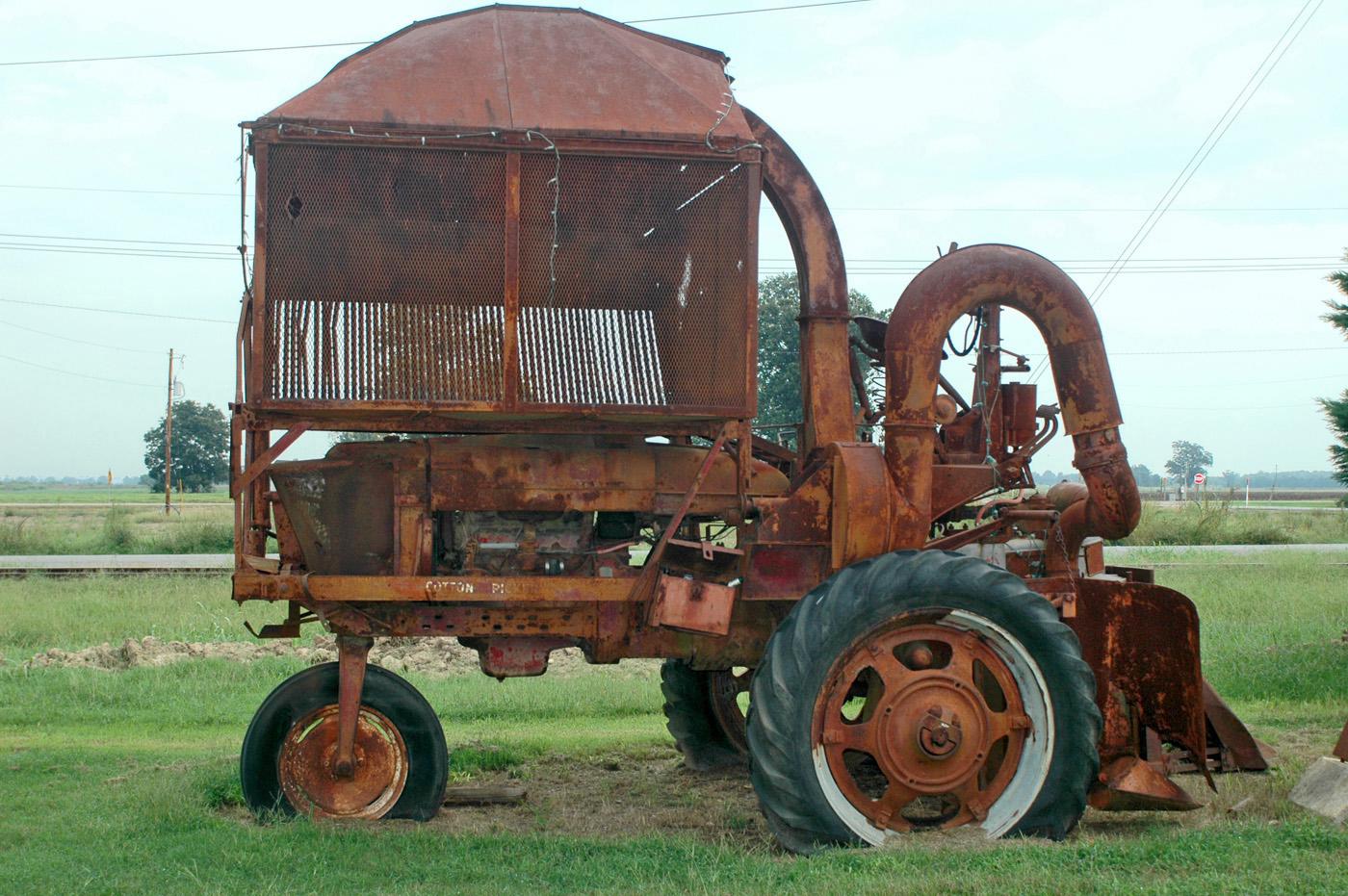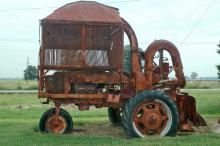Information Possibly Outdated
The information presented on this page was originally released on January 3, 2008. It may not be outdated, but please search our site for more current information. If you plan to quote or reference this information in a publication, please check with the Extension specialist or author before proceeding.
Historic Delta research changed cotton farming
CLARKSDALE -- Covered only with a coat of rust and adorned with a string of lights from a Christmas past, the vintage machine sitting on the edge of Highway 49 near Clarksdale is a reminder of a revolution that took place in southern agriculture more than 60 years ago.
The M12H International Harvester cotton picker was produced in the late 1940s and was among the second generation of commercially successful cotton pickers to hit the market. It is located on the Hopson Plantation, the site of field tests for mechanical pickers from the 1920s through the 1940s.
Picking cotton by hand was a sunup to sundown job, and a good picker could harvest about 250 to 275 pounds of cotton a day. About 1,200 pounds of hand-picked cotton is needed to produce a 500-pound bale of cleaned, dried lint ready for market.
“The long hours of back-breaking hand labor needed to produce cotton led to a lot of interest in mechanical pickers as far back as 1850,” said Mississippi State University Extension Service agricultural engineer Herb Willcutt. “The first known patent for a cotton picker was issued to S.S. Rembert and Jebediah Prescott of Memphis in 1850.”
During the years that followed, engineers experimented with machines that removed cotton from bolls in a variety of ways, including the use of vacuum pumps to suck out the lint. Machines using spindles to separate lint from bolls proved the most successful.
“These machines use rows of barbed spindles rotating at high speed to remove the cotton from the plant. The cotton is then removed from the spindles by a counter-rotating cylinder called a doffer,” Willcutt said.
The Mississippi Delta was a popular testing ground for mechanical pickers because of its location in the heart of the nation's Cotton Belt, the large number of acres devoted to cotton production in the region and the location of U.S. Department of Agriculture scientists at the Delta Branch Experiment Station.
By the late 1920s, several companies, including John Deere and International Harvester, or IH, had research and development plans for mechanical pickers and were getting close to commercial production. Economics, however, dealt their projects a serious blow.
“The 1929 stock market crash and the Great Depression dropped cotton prices to just 5 cents a pound and brought development of mechanical pickers to a standstill,” Willcutt said. “However, IH resumed work on its tractor-mounted pickers in the early 1930s.”
Testing of the IH machines and machines produced by the Rust Cotton Picker Co. in Memphis took place at the Delta Branch throughout the 1930s, and IH sent engineers and prototype pickers to the Hopson Plantation.
A 1936 demonstration of the Rust tractor-pulled mechanical picker at the Delta Branch triggered an editorial in the Jackson Daily News stating that the machine “should be driven right out of the cotton fields and sunk into the Mississippi River,” out of fear that it would put millions of people out of work.
At the Hopson Plantation, IH engineers from the company's Chicago headquarters were able to troubleshoot problems as they developed.
“The first pickers didn't have a dump basket, and the cotton had to be unloaded to a wagon by hand,” said Walter Nance, a member of the Hopson family who grew up on the plantation during the 1940s. “One day, the engineers came in exhausted from unloading a picker basket, and they sat down under a tree and designed a dump basket. They took their plans back to Chicago, and when they came back the next fall they had a mechanical dump basket.”
While the IH engineers were working at the Hopson Plantation, USDA and Mississippi State researchers at the Delta Branch were studying mechanical pickers and conducting research on strengthening cotton fibers to withstand mechanical harvesting. The Delta Branch also was the site of research with defoliation, which was needed to remove the leaves from cotton plants before mechanical harvesting.
The work at the Delta Branch Experiment Station and at the Hopson Plantation led to commercial production of IH mechanical pickers, while war-time demand for factory workers was easing concern about the impact of replacing much of the South's farm workforce with machines.
In 1942, IH produced 12 mechanical pickers on Model H Farmall tractors, and in 1943, 13 more were mounted on the Model H tractors and one on a larger Model M. Production increased to 40 of the machines for use on Model M tractors for the 1944 crop. Also in 1944, the Hopson Plantation produced the first cotton crop using just mechanical cultivation and harvesting, a feat that made the farm a tourist attraction.
“They've come from all over the Cotton Belt,” said Dick Hopson, one of the two brothers operating the plantation at the time, in a 1944 interview for ACCO Press, a cotton magazine. “Men from the eastern mills, bankers, in fact, just about every phase of the cotton business has been represented in those who have come to observe the picking operation this year.”
Also in 1944, the Delta Branch used an IH mechanical picker to harvest its cotton crop, marking the first time the experiment station successfully produced a cotton crop without a single hour of hand labor. The move to mechanization also spelled the end of mule power at the facility. In 1945, a new mule barn housed 40 mules, but by 1950, only one remained at the station.
Engineers had produced a machine that could pick cotton of comparable quality to hand picking and at a faster pace, concerns remained about the economics of mechanical harvesting.
“They had a production model that was satisfactory, but it still had to be proved that this was a practical, economic thing,” Nance said. “So, the plantation had three bookkeepers with the most extensive cost accounting setup known to man at the time. Every nut, every bolt, every quart of oil, everything was accounted for in order to compare mechanical production to the hand labor used in the sharecropping system. They did prove that mechanical farming was economically practical.”
Mechanized production of cotton and other crops increased after World War II. A significant step forward was John Deere's 1951 volume manufacturing of two-row cotton pickers. Today, six-row machines are the standard, but they still operate on the engineering principles developed more than 60 years ago.
“Current cotton pickers still use most of the concepts introduced in the 1943 IH production pickers,” Willcutt said. “However, one six-row harvester operating at 4.2 miles an hour in two-plus-bales-per-acre cotton can harvest 150 to 200 bales of high-quality fiber a day with a crew of three or four people. It would take 750 to 1,000 people to harvest the same amount by hand.”
The Hopson Plantation has been designated a Mississippi Landmark for the role played there in the development of mechanical cotton harvesting.
The M12H picker parked near the plantation's former commissary is part of Delta history, said James Butler, who along with his wife, Cathy, a member of the Hopson family, own the area that served as the plantation's headquarters. The commissary building is now a blues club, and former sharecropper houses and the gin building on the property are part of an inn that draws visitors from around the world.
“We would like to eventually restore the machine to the way it was in the 1940s when the plantation was part of important changes in Delta life,” he said.




